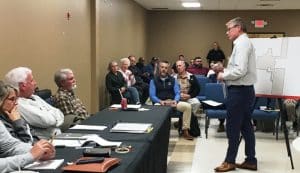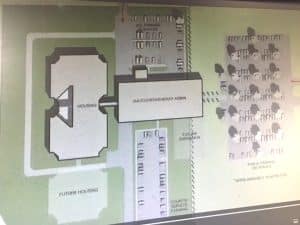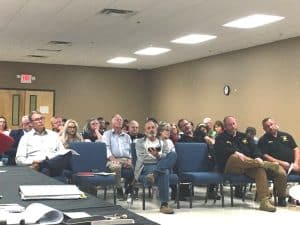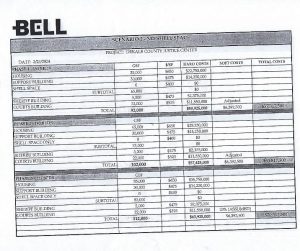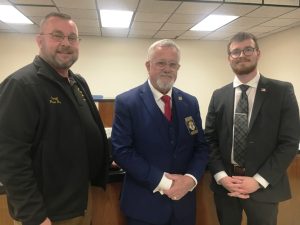News
Suspected Drug Trafficker Caught Exchanging Narcotics with Woman in Walmart Parking Lot
February 29, 2024
By: Dwayne Page
A man believed to be trafficking illegal narcotics was caught by the DeKalb County Sheriff’s Department Tuesday exchanging drugs with a woman in the Walmart parking lot. Both have been charged with felony drug offenses and will make a court appearance March 14.
45-year-old Jerry Henry Goff of East Main Street, Smithville is charged with possession of the following controlled substances with intent to manufacture, sell, or deliver: Adderall (schedule II), Buprenorphine (schedule III), Oxycodone (schedule II), Psilocybin Mushrooms (schedule I), Gabapentin (schedule V), Marijuana (schedule VI), Methamphetamine (schedule II), and Fentanyl (schedule II). His bond totals $257,000.
29-year-old Amber Cheyenne Barrett-Caldwell of Pine Orchard Road, Smithville is charged with possession of Methamphetamine (schedule II) with intent to manufacture, sell, or deliver. Her bond is $60,000.
Sheriff Patrick Ray issued the following statement on the investigation that led to the arrest of Goff and Caldwell.
“On February 27 while in an undercover capacity, detectives with the DeKalb County Sheriff’s Office were conducting surveillance on Jerry Goff due to receiving numerous reports of him trafficking illegal narcotics. While surveilling Goff at the parking lot of Wal-Mart, detectives observed an early 2000’s model truck pull up to the Dodge Nitro driven by Goff and a hand-to-hand transaction was made”.
“Detectives then stopped both vehicles to find Cheyenne Barrett-Caldwell to be the driver of the early 2000’s model Chevrolet truck. Goff, who is currently on state probation was searched along with his vehicle”.
“Detectives recovered 38 blue pills believed to be Oxycodone and a large sum of cash. The search of Cheyenne Barrett-Caldwell revealed 29.77 grams of a crystal-like substance believed to be Methamphetamine”.
“After leaving the scene at Wal-Mart, detectives along with deputies from the DeKalb County Sheriff’s Office went to the residence of Goff located at 624 East Main Street in Smithville to conduct a search of his residence. After the search of Goff’s home detectives recovered an additional large sum of cash along with 4 Adderall pills, 2 pink Oxycodone pills, 18 Buprenorphine pills, 3.43 grams of Psilocybin Mushrooms, over 100 Gabapentin pills, 92.24 grams of marijuana. and 55.4 grams of fentanyl. Detectives further recovered numerous items of drug paraphernalia including digital scales, syringes, spoons, straws, and other items. Detectives also seized the 2008 Dodge Nitro along with $5,636.00 in cash from Goff,” said Sheriff Ray.
(UPDATED) Commission Gets Sobering Report from Architect and Contractor on Jail/Judicial Center Construction Costs (View Video Here)
February 28, 2024
By: Dwayne Page
An eye opener!
For the first time, the jail committee of the county commission has been presented schematic site plan scenarios of what a judicial center might look like and how much it would cost.
During a meeting Tuesday night, John Eisenlau of Treanor Architects and Rick Bruining of Bell Construction unveiled options for a 150, 190, and 225 bed facility as requested by the jail committee in January. Based on the three options presented by Bell, the projected cost of judicial center construction ranges from $57,317,500 for a 150-bed jail (with no shell space for future expansion) to $70,317,500 for a 225-bed facility. The projected cost of the court complex alone is $11, 550,000 and the estimated design services fees based on 6% of the construction value is $3,000,000. These numbers do not include whatever the cost may be to purchase property for the project, if necessary.
Although he was not at the meeting Tuesday night, the county’s fiscal agent Steve Bates, provided as requested information on the type of funding stream that would be needed to support the debt based on these options.
“Assuming that the net value of one cent of the property tax rate generates $61,450, the costs for a $57,315,000 project (for the 150-bed option) would require either a 59 cent (property tax increase) to amortize a $3,595,000 debt or a combination $50 wheel tax and 41 cent property tax increase,” wrote Bates.
If the county were to choose the $70,317, 500 option for a 225-bed facility, a 72-cent property tax hike would be needed to amortize a $4,410,000 debt or it could be funded through a $50 wheel tax and a 54-cent property tax increase, according to Bates.
Bates further explained that “these estimates are on the high (side) since rates are so volatile. Interest income during construction and bonds sold at a premium will allow for some adjustments”.
In addition to this information, County Mayor Matt Adcock announced that he has been in contact with another landowner, Jerry Dwayne Foster who has 57.59 acres near Allen’s Ferry Road behind Bizee Mart that he is willing to sell to the county at a price of $1.3 million. The property is currently not in the city limits but could possibly be annexed.
If the county were to go forward with a building project, Eisenlau explained that the final plan might look different from the scenarios presented Tuesday night.
“This gives you a general sense of the size of the building and how it would lay out on the land,” said Eisenlau. “What we were asked to do was show what a building that has roughly 150 individuals (prisoners) would look like and if you had 190 individuals or 225; how much property is needed; and a rough estimate of the cost. We use some simple benchmarking when we do projects like this. We usually have a rough idea what the square footage is but your building based on everything you see on paper here today will probably not look exactly like this because we have not had a lot of time to talk to the sheriff’s department or the judiciary on how it would function. We typically do that over the course of a couple months but when I was asked to give it my best shot, 30 days later this is it as to what it may or may not look like,” said Eisenlau.
Both single story and two-story building options were offered which include the jail and inmate housing facilities, three courtroom complex, sheriff’s administration building, and parking areas altogether consisting of 100,000 square feet on 13.5 acres. In each scenario, Eisenlau said the jail would house prisoners on the first floor with a second story mezzanine to house more inmates. In the second option, the entire complex would be a two-story structure. When asked about the difference in cost, Bruining said a single-story structure is usually about 12-15% more.
“We laid the building out this way largely because if you choose just to build the jail now, which you could with the jail operations and the housing, you could add the courts and the sheriff’s operation at a later date. This scheme is expandable like a campus type plan,” said Eisenlau.
After learning how costly the project as presented would be, several county commissioners suggested that the architect and contractor take another look at the existing jail location and possibly come up with a phased renovation/expansion plan for that site, something the public might more likely embrace.
“I’m not ready to vote on anything until we explore our options because I don’t know if the county can afford this right now, but I think the existing jail site is a good option to at least explore. If we can put it (new jail) on the existing site, I think it will help us a lot especially if we can put the courtrooms above it (jail) for the criminal court cases and keep the courthouse for the civil cases,” said Commissioner Tony Luna.
“What’s the need for three new courtrooms if we are going to keep the ones we have (courthouse). Do we really need five courtrooms in DeKalb County,” asked Commissioner Daniel Cripps.
“When we voted on (recommending a judicial center in November) we were not talking about using the courthouse for civil cases and we were not looking at this kind of costs,” said Commissioner Larry Green.
“Given these numbers, I’m not sure we can afford this,” added Commissioner Green. “ If we built 100 beds out from where we are at now (current location) on another (adjacent) piece of property out there and then tear down what we have now (jail annex) and build back there we could possibly phase it in,” said Green.
“I agree with Larry,” said Commissioner Andy Pack. “We are in this situation because the jail is not meeting state requirements. That’s what we need to be concentrating on is the jail itself. The people I have talked to in the sixth district and others are not sold on this idea (buying property for judicial center). They are strongly wanting us to try to make that existing property work,” he said.
“Can you do a plan for where our jail is currently located and what it would cost,” asked Commissioner Beth Pafford.
“We could do an attempt to fit it on your current site,” answered Eisenlau.
“I think its an important thing to do,” Pafford said.
“I know they (county) own the veterans building where the sheriff’s department has offices now, which is behind the school board (building). I know back when Mark Willoughby was Director of Schools, I remember hearing them talk at that time about if a new school was built they could move their school board offices to the Smithville Elementary building and perhaps the county could take that building (Ernest Ray Education Center) that’s on the corner,” Pafford said.
“There are a lot of people in the county that either think we can modify the existing building (jail annex) or that’s where it (new jail) should be because they would like to see it downtown. I think it behooves us as a commission to show those people whether that would work or not and what the cost would be compared with other options we have looked at. Unless I am wrong in my vision of what that piece of property looks like there is no way we can build something next to what we have without either having the school board building and veterans building or that other piece of property there we don’t own. Consider if you had that whole block what could you do,” said Commissioner Tom Chandler.
“It behooves us to do the research and share it with the people to let them see so that there is better understanding overall as to what we are looking at and obstacles that we do or don’t have for each type of building and location,” said Commissioner Susannah Cripps Daughtry. “ To make it a justice center adds $11.5 million dollars to this total gig and that’s a lot of money especially when we also have other things we need to be doing. It comes down to maximizing the resources we currently have and figuring out what we can do and save some money,” she said.
Commissioner Greg Matthews, who has worked in law enforcement , said too often past county commissions have not fully addressed county needs such as this and he doesn’t want to see that pattern continue with this commission
“Some of these alternative measures of building here or there, to the left or right just shakes my soul as the only person here to ever run a criminal justice center on the functionality and safety of everybody who is going to work there,” said Commissioner Matthews.
“Secondly, we are talking about getting a building not owned by us (school board property) and there would first have to be a new school built which may be four or five years down the road. We can’t push this off because by law we are obligated to have and maintain a jail,” Matthews continued. “ Its not my thing to push this on down the road. If somebody else buys that 57 acres (Foster property) someday we will pay some stupid or ridiculous amount for land because there’s not that much of it (available) out there. I don’t see wasting this guy’s (architect) time to do a bunch of stuff (making new site plan), adding in a school board building, knowing we’re looking at seven or eight years down the road before we could even start a new jail or justice center”.
“Thirdly, the last add-on to the jail (in 2001) was a joke,” Matthews said. “It was built at the cheapest budget and within a year people were escaping out the roof and tearing everything apart. I don’t want to be known 10 years from now as another commission that did nothing. I agree with the idea of stacking to save money, but we are obligated to make sure our county has what it needs also. We are to spend money but to spend it wisely. I think we should look at the acres by Allen’s Ferry because we have a (new) health department (project) that is fully funded (with state and local ARP funds) and ready to be built and we have nowhere to put it. Those 57 acres could allow DeKalb County to have future growth,” Commissioner Matthews explained.
Should the county decide to proceed with building only a 150-bed jail, Matthews said it would be overcrowded by the day it opened and would fail to meet state certification.
“One of the quotes here is for a 150-bed jail. Before Covid, numbers provided by Jim Hart of CTAS (who performed a jail study) and Sheriff Patrick Ray showed that the average daily jail count in this jail was 130 males and 28 females for a total of 158. Adding the state required bare minimum 15% (calculation) for (inmate) classification (segregating sex offenders and violent offenders, etc. from the non-violent offenders) is another 24 beds so that puts the minimum need at 182 beds based on numbers provided by Jim and Patrick. Therefore a 150-bed justice center fails (state certification) right off the bat. I don’t see spending money for anything that is going to fail the day it opens,” said Commissioner Matthews.
Bob Bass, Deputy Director of the Tennessee Corrections Institute, the entity that inspects and certifies jails, attended Tuesday night’s meeting and when asked said overcrowding can be a factor in determining or maintaining certification.
“If you open up a brand-new jail and its already overcrowded you would be under a plan of action. We have had that happen,” said Bass.
Several members of the public were also in attendance and asked questions near the end of the meeting during the public comment period. Some of the questions were directed to Bass who explained that while TCI could not make a county build a jail it is important that jail certification be maintained or risk liability.
Without TCI’s certification, a county could be subject to state or federal litigation in which a judge, particularly a federal judge, could force costly construction of a jail to federal standards with the possibility of accumulating costs of fines to the county until construction is completed.
“There are 124 jails operating in Tennessee and only five are not certified and they are really at risk,” said Bass.
After hearing from the commissioners, County Mayor Adcock said he would instruct the architect and contractor to do another study of the existing jail location although a previous one concluded that the site was perhaps too small and unsuitable for a rebuild or expansion.
Acting on Bass’s suggestion, Mayor Adcock said he plans to schedule a town hall style meeting with the commission and Bass to engage the community and better enlighten the public on the issues and needs regarding the jail.
More than four years ago the county initiated a long-term plan of action through a partnership with Tennessee Corrections Institute (TCI) and County Technical Assistance Service (CTAS) in order to keep the jail state certified until deficiencies were addressed. As part of that plan the sheriff had to submit and still has to submit monthly progress reports to TCI on what measurable progress is being done by the county to eventually make the jail compliant with the standards established by the state. Immediately after forming the partnership, the county requested that CTAS conduct a feasibility study of the jail operation which has been done that counts toward the ‘measurable progress “requirement as do meetings with TCI and CTAS like the one held by the county ‘s jail committee Tuesday night.
At a meeting on January 18, 2023, TCA Deputy Director Bob Bass suggested that the county commission start thinking about developing a master plan.
“A master plan would allow us to set up those steps to identify where you want to be six months from now, finding out cost factors and things like that, finding the property to put it (building project) on and all along the way the county commission could vote to either move forward or stop. There is no specific time limit. It takes time to get these things done. You could be in a plan of action three years. If you made a decision to build a jail tonight just in the design phase alone it would be a year so that plan of action is a good thing to have and as long as you have it and show measurable progress, we are not going to take away your certification,” said Bass.
In February 2023 County Mayor Adcock unveiled his own master plan proposal for the county commission to consider during a jail committee meeting which provided a detailed three-year timeline for the planning and eventual construction of either a criminal justice center or a new jail.
Six months later in August 2023 during a visit here, TCI officials determined that the jail’s number of certifiable beds at 102 (78 males and 24 females) must be reduced to no more than 52 (16 females and 36 males) almost immediately and that the basement portion of the older jail facility, which housed 23 inmates, could no longer be used for that purpose. Among the concerns triggering this move by TCI. although not new, were that portions of the jail do not meet the state’s per prisoner square footage clear floor space requirement for authorized housing and the jail basement had no natural light. There were also other issues at both the older jail facility and the jail annex. Since August, several inmates have been relocated to other jails, but DeKalb County is having to foot the bill for that at up to $55 per day plus the cost of transporting them back and forth to court here.
In November 2023, the county’s jail committee voted to recommend to the full county commission that a new judicial center be built rather than a jail once a suitable site has been selected for the project. After spending months weighing both options, the jail committee came to the conclusion that a judicial center would better meet the county’s needs than a new jail and perhaps be less costly in the long run. No decision was made then or has been made since on a funding option or when the county should move forward and so far, no property has been acquired for a new jail/judicial center although several potential sites have been mentioned or considered.
Unless a new jail is built in close proximity to the courthouse, County Mayor Adcock said the sheriff’s department would have to transport prisoners back and forth from the jail to the courthouse every time court is in session and that could have an impact over time on the county budget in terms of fuel, personnel, vehicles, and other costs. That would not necessarily be the case if a judicial center is built, according to Adcock because the entire operation of the sheriff’s department, jail, and judicial system (courtrooms and clerks offices) would be in the same complex. And while a jail can be built outside the city, a judicial center, by law, must be inside the city limits of Smithville.
Also, in November 2023, Steve Bates, the county’s fiscal agent/financial advisor said that the estimated cost difference in building a jail versus judicial center initially would be $10 million ($50 million for a Judicial Center or $40 million for a Jail). In either case, County Mayor Adcock said a new revenue stream would be required to fund it whether it be a higher property tax rate, the implementation of a wheel tax, or a combination of the two.
Bates advised the jail committee to start thinking about how the county should fund the project and the sooner the better. “You will need a full year’s collection if we issue bonds in fiscal 2024-25. You must have money start coming in to put in debt service. Your debt management policy says at a minimum you must have 80% of debt service requirement in your debt service fund. We only have about $2 million in debt service right now, so we will need more money,” said Bates.
“You don’t want to find yourself with a payment when you’re not going to get any new revenue for months later. That puts you behind the eight ball,” he added.
The county’s justice committee recently recommended, and the county commission approved the selection of Treanor Architect based on Atlanta, Georgia and Bell Construction of Brentwood for consultation purposes for the jail/judicial center building project.
In January 2024, the Jail committee of the DeKalb County Commission met and voted to have the county’s architect and contractor come up with costs projections for a possible 150, 190 or 225 bed facility.
During the meeting, Jim Hart, Jail Consultant and Field Manager of the County Technical Assistance Service (CTAS) updated the committee on the county’s revised jail assessment study done by CTAS which now recommends up to 272 beds to meet current and future needs.
Results of the architect and contractor’s analysis of cost projections were provided to the jail committee/county commission Tuesday night, February 27.
Peyton Norris named DCHS Class of 2024 Valedictorian and the Salutatorian is Kathryn Hale
February 28, 2024
By: Dwayne Page
DeKalb County High School has released the names of the 44 Top Rank and 35 Honors students in the Class of 2024 including the Valedictorian Peyton E. Norris and Salutatorian Kathryn A. Hale.
Norris is the daughter of Jonathan and Jenny Norris and Hale is the daughter Shannon and Yvonne Hale.
To be considered for top Rank, students must take at least 10 honors, dual enrollment, and AP courses and students must have a 21 or higher ACT composite score.
The DCHS Class of 2024 Top Rank students are as follows:
Peyton E. Norris, Kathryn A. Hale, Maleah P Ruch, Kendall M. Davis, Alexander H. Antoniak, Ian D. Colwell, Kaleb T. Spears, Jackson W. Vantrease, Konner G. Young, Jade A. Mabe, Tess A. Barton, Patyn L. Carter, Nathaniel D. Wessel, Ella J. Hendrixson, Karson J. Smallwood, Allyson R. Fuller, Paul D. Oliver, Ella G. VanVranken, Daniela Amaya, Jacob B. Hendrix, Micah L. Gandy, Carson J. Vincent, Serenity E. McCrary, Kyra M. Baker, Conner T. Close, Jaxon D. Humphrey, Briahna R. Murphy, Olivia P. Diego, Lilly H. Waggoner, Zackery W. Farris, Cadence A. Griffith, Dominique C. Young, Devin W. Holt, Makaylee A. Winchester, Madelyn R. Johnson, Evelyn J. Mitchell, Briz Trapp, Caroline G. Tobitt, Ethan L. Thompson, Matty M. Hollingsworth, Topanga T. Patrick, Xavier M. Parker, Elvia A. Sanchez, and Gavin W. Cooper.
The following students have met the requirements for graduating with Tennessee State Honors by meeting all of the ACT or SAT subject area readiness benchmarks. The ACT benchmarks are as follows: English-18, Reading-22, Math-22, and Science-23. The SAT benchmarks are as follows: Evidence-Based Reading and Writing-480 Math-530
Daniela Amaya, Alex Antoniak, Tess Barton, Payton Carter, Ian Colwell, Gage Ikonen, Kendall Davis, William Dickens, Olivia Diego, Briana Fletcher, Micah Gandy, Kathryn Hale, Tristan Hall, Jacob Hendrix, Ella Hendrixson, Devin Holt, Jade Mabe, Serenity McCrary, Evelyn Mitchell, Peyton Norris, Paul Oliver, Xavier Parker, Markaya Rebertus, Maleah Ruch, James Slager, Lucas Spare, Kaleb Spears, Ethan Thompson, Jackson Vantrease, Lily Waggoner, Jazmine Wagner, Owen Warren, Nathaniel Wessel, Dominique Young, and Konner Young.
« First ‹ Previous 1 158 248 256 257 258259 260 268 358 2507 Next › Last »









